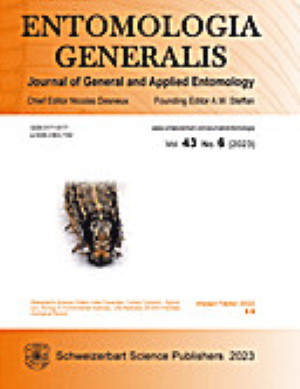减少施肥对天敌和生物防治效果的自下而上的影响
IF 4.6
1区 农林科学
Q1 ENTOMOLOGY
引用次数: 0
摘要
在农业生态系统中,节肢动物群落可能会受到环境变化(如施肥)通过改变植物性状而诱发的自下而上力量的影响。自下而上的作用力如何影响第二营养级已有详细记载,但这些作用力如何逐级影响到第三营养级却鲜为人知。我们的目的是了解:1)生态环境截然不同的天敌(即寄生虫和捕食者)之间的自下而上效应有何不同;2)捕食者的饮食结构如何影响自下而上效应的强度。我们建立了一个实验室实验,测量减少施肥量(从标准施肥量到不施肥)对番茄三营养系统的影响。所选的食草动物是番茄系统中的常见害虫(Macrosiphum euphorbiae、Bemisia tabaci 和 Tuta absoluta)。相应的寄生虫为 Aphidius ervi 和 Encarsia formosa,捕食者为 Adalia bipunctata(肉食性)、Macrolophus pygmaeus(杂食性)、Dicyphus errans(杂食性)和 Chrysoperla carnea(肉食性)。我们记录了植物生长和叶片碳氮含量、食草动物繁殖力以及寄生虫/捕食者的各种特征,包括发育、寿命、繁殖和生物防治效果。我们发现,根据食草动物类型的不同,自下而上的作用力通过营养级被稀释,从高级到中级减少施肥量对寄主质量和生物防治效果的影响各不相同,但总体上略有积极影响。总体而言,寄生虫受到的影响小于捕食者。这项研究为害虫综合防治提供了新的视角,减少施肥量有助于更好地控制害虫数量,同时不会对植物生长和产量产生重大影响。本文章由计算机程序翻译,如有差异,请以英文原文为准。
Bottom-up effects of reduced fertilization on natural enemies and biocontrol efficacy
In agroecosystems, arthropod communities may be influenced by bottom-up forces induced by environmental variations (e.g., fertilization) through the modification of plant traits. The way bottom-up forces affect the second trophic level is well documented, but how these effects cascade to the third trophic level is less understood. We aimed to understand: 1) how bottom-up effects vary between natural enemies with contrasted ecology, i.e., parasitoids and predators; and 2) how the diet regime of the predators affected the intensity of bottom-up effects. We set-up a lab experiment measuring the effects of reduced fertilization (from standard rates to no fertilization) on tri-trophic systems in tomato. The selected herbivores are frequent pests on tomato systems (Macrosiphum euphorbiae, Bemisia tabaci and Tuta absoluta). The respective parasitoids were Aphidius ervi and Encarsia formosa, and the respective predators Adalia bipunctata (carnivorous), Macrolophus pygmaeus (omnivorous), Dicyphus errans (omnivorous) and Chrysoperla carnea (carnivorous). We recorded plant growth and leaf carbon and nitrogen content, herbivore fecundity as well as various parasitoid/predator traits including development, longevity, reproduction and biocontrol efficacy. We found evidence of diluted bottom-up forces through trophic levels depending on the herbivore types, with variable but overall marginally positive effects of reducing fertilization from high to intermediate levels on host quality and biocontrol efficacy. Parasitoids were overall less affected than predators. This work offers perspectives in the framework of Integrated Pest Management where reduced fertilization may help better control pest populations without significant impacts on plant growth and thus yield.
求助全文
通过发布文献求助,成功后即可免费获取论文全文。
去求助
来源期刊

Entomologia Generalis
生物-昆虫学
CiteScore
7.10
自引率
18.80%
发文量
72
审稿时长
>12 weeks
期刊介绍:
Its scope covers all aspects of basic and applied research dealing with insects and more broadly with arthropods inhabiting wild, agricultural and/or urban habitats. The journal also considers research integrating various disciplines and issues within the broad field of entomology and ecology.
Entomologia Generalis publishes high quality research articles on advances in knowledge on the ecology and biology of arthropods, as well as on their importance for key ecosystems services, e.g. as biological control and pollination. The journal devotes special attention to contributions providing significant advances (i) on the fundamental knowledge and on sustainable control strategies of arthropod pests (including of stored products) and vectors of diseases, (ii) on the biology and ecology of beneficial arthropods, (iii) on the spread and impact of invasive pests, and (iv) on potential side effects of pest management methods.
Entomologia Generalis welcomes review articles on significant developments in the field of entomology. These are usually invited by the editorial board, but proposals may be sent to the Editor-in-Chief for preliminary assessment by the editorial board before formal submission to the journal. The journal also considers comments on papers published in Entomologia Generalis, as well as short notes on topics that are of broader interest.
 求助内容:
求助内容: 应助结果提醒方式:
应助结果提醒方式:


